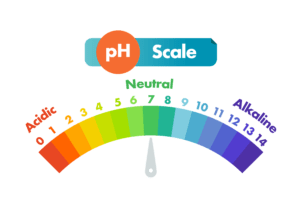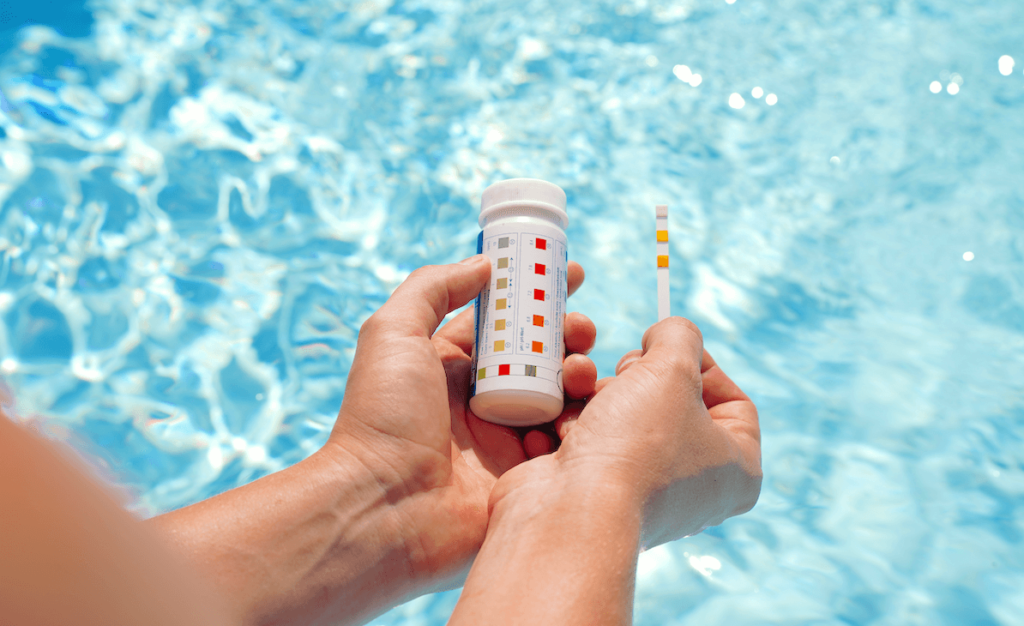Do you know the reason why lemon juice or certain soaps burn our eyes? It’s because our eyes are sensitive to substances that are too low or too high in pH. Similar to your eyes, it’s critical to make sure your swimming pool’s pH is in the ideal range.
When maintaining your swimming pool water, pH is the most important element in balancing water chemistry. But before you learn how to regulate your swimming pool’s pH, it is important to know what pH is and how it can affect the comfort, equipment, surfaces and sanitation of your swimming pool.

What is pH?
In short, pH measures acidity. In pool chemistry, the pH, or potential of hydrogen, scale tells you how acidic or basic your swimming pool water is. The pH scale ranges from 0 to 14, with 7 being neutral. For proper swimming pool pH, the ideal level is somewhere in the 7.2 to 7.4 range. Pool water that has a pH below 7 is acidic and above 7 is basic or alkaline. For example, acidic substances that are low in pH include lemon juice and vinegar, while alkaline substances that are high in pH include certain soaps and stomach relief tablets. The human eye’s ideal pH level is around 7, which is why acidic lemon juice or alkaline soap will irritate your eyes.
When balancing your swimming pool’s pH, it’s important to avoid pH that is too high or too low, as both can pose problems. If your pool has improper pH levels, it can lead to equipment damages, low water quality, and eye and skin irritation.
Pool pH Too High or Too Low? No pHroblem
It’s important to know that anything that is added or that comes in contact with your pool water will have an influence on the pH, the greatest influencer being your sanitizer. While Clear Comfort’s AOP pool sanitation is pH neutral, chlorine can easily tamper pH levels. Understanding the chemical characteristics of your primary sanitizer is the first step in choosing the best pH chemical for your needs.
Whether you are building a new pool, renovating equipment, or just looking to optimize your current pool system, there are a number of options available for you to regulate your pool’s pH.
Acidic Sanitizers That Lower pH
If your pool’s chlorine levels are high, it can decrease your pool pH, resulting in acidic water. Pool water that’s acidic and has low pH can cause your pool surfaces to corrode and etch, which can hurt the value of your pool.
Please Note: If you’re looking for a pH-neutral pool sanitation method that can minimize chlorine down to drinking-water levels, the industry’s leading best practice is Clear Comfort’s AOP pool treatment.
Pool sanitizers have pH levels that range anywhere from 2.8 to 14.0, so it’s critical to know how a sanitation method will impact your pool’s pH remediation system. Here are four primary sanitizers that will lower your pool’s pH:
- Gas chlorine: An extremely efficient sanitizer, but it can also be very dangerous if not handled carefully so there are fewer and fewer pools using it.
- Dichlor or Trichlor: Often known as chlorinated isocyanurates, dichlor and trichlor are solid chlorine compounds that are often used in residential pools and in hotels, motels and apartment complexes. Since trichlor and dichlor contain both chlorine and cyanuric acid, or CYA, they can raise your CYA levels over time. To learn more about CYA, please take a look at our blog post “Cyanuric Acid: Friend or Foe”. Additionally, in August 2020, Hurricane Laura struck the largest trichlor chemical plant, causing the current chlorine shortage and the expectation of trichlor prices increasing by 70 percent in a year.
- Bromine: A less common option as it is more expensive than chlorine and not as powerful of an oxidant, but it is occasionally found in hot tubs because it’s more stable in higher temperatures.
How to Raise Your Pool’s pH
Have you ever got green hair after swimming? Despite the common misconception, green hair after swimming is not from chlorine, but rather copper in solution due to heat exchangers and other equipment eroding in corrosive pool water.
If your pH is too low and acidic, you can raise pH and alkalinity by periodic manual additions of a basic chemical, like sodium bicarbonate or soda ash. Typically, manually adding soda ash will commonly cloud up the water for a period of time due to calcium coming out of the solution at the high pH where the chemical was broadcast into the water. In addition, aerating the pool water through jets, fountains, waterfalls, etc. can help to raise the pH by driving carbonic acid out of the solution.
Basic Sanitizers That Raise pH
High pH can cause cloudy water and create scale, which is a crystalline buildup of inorganic materials, like calcium, that creates a white film around your pool’s water lines.
Higher pH can greatly diminish sanitizer and disinfectant performance in the water. It is important to understand that you get higher chlorine efficiency at a lower pH so it is advisable to operate on the low end of the range if your saturation index allows. For homeowners, the most common primary sanitizers that increase pH are:
- Sodium hypochlorite: Commonly known as liquid chlorine or bleach, sodium hypochlorite has a natural pH of around 13 and is rarely used on pools alone because it’s very unstable.
- Calcium hypochlorite: Calcium hypochlorite, or cal hypo, is both an oxidizer and sanitizer and is the most frequently used in the pool industry. With a pH around 11.8, depending on the concentration, cal hypo will require acid remediation to help lower the pH.
How to Lower Your Pool’s pH
If your pool’s pH is above the ideal 7.2 to 7.4 range, this means we must add something to bring that pH down. But does it really matter which chemical you choose to lower pH? Here’s some helpful information on today’s top three pH-lowering chemicals:
- Muriatic acid: Muriatic acid (HCI) is the most common pH lowering chemical, widely available and very effective but it is also the most hazardous to handle with both liquid and vapor forms being harmful to people and equipment. Muriatic acid also lowers alkalinity requiring remediation usually through manual additions of sodium bicarbonate.
- Sodium bisulfate: Sodium bisulfate (NaHSO4) is very similar to muriatic acid except that it is in a dry form either in granules or more recently in puck form designed for specific erosion feeders. Sodium bisulfate also lowers alkalinity, much like muriatic acid.
- Carbon dioxide: Another option for lowering pH is carbon dioxide or CO2. However, unlike the other two acids, CO2 will result in a gradual increase in alkalinity. One of the most efficient ways to balance pH and alkalinity is to set up a combo system of CO2 and either muriatic acid or sodium bisulfate and feed either in balanced unison or one at a time manually with a crossover switch. This can keep the alkalinity in the proper ranges without ever having to manually add chemicals to adjust the alkalinity.
How To Be Proactive With Pool pH
While knowing how to raise or lower pH is a great starting point for your pool’s pH remediation system, you also need to understand the pH impacts from your water source. How will you know how to adjust your pool’s pH if you don’t know the water’s starting point? Since water sources can significantly vary in pH levels and other minerals, you’re doing yourself a great disservice if you don’t understand the pH of your source water.
Of course, choosing the right pool sanitation system can help you save time, money and headaches over balancing your pH. In any case, Clear Comfort’s AOP pool treatment is the industry’s best practice for pH-neutral sanitation that helps boost oxidation, minimize chlorine and reduce the negative effects of imbalanced pH.
It’s important to understand that pool water with a pH level above the neutral 7.0 can still be corrosive if the water is not balanced within the Langelier Saturation Index, or LSI, proper ranges.
Maintaining proper pH balance for your swimming pool can be challenging, but it’s the most important part of balancing your pool water chemistry. Once you start your pH remediation system, by minimizing pH-raising chlorine with AOP, regularly testing water chemistry and making minor maintenance adjustments, you’ll be ready to swim safe and happy in the best water quality possible.







